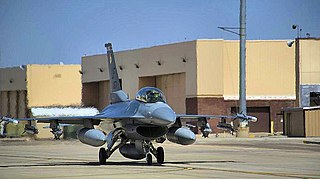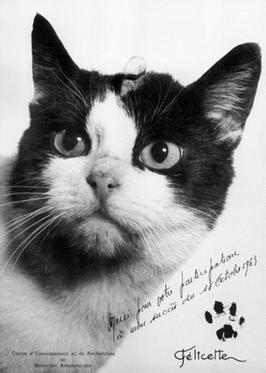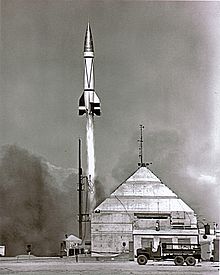
Project Mercury was the first human spaceflight program of the United States, running from 1958 through 1963. An early highlight of the Space Race, its goal was to put a man into Earth orbit and return him safely, ideally before the Soviet Union. Taken over from the US Air Force by the newly created civilian space agency NASA, it conducted 20 uncrewed developmental flights, and six successful flights by astronauts. The program, which took its name from Roman mythology, cost $2.57 billion. The astronauts were collectively known as the "Mercury Seven", and each spacecraft was given a name ending with a "7" by its pilot.

This article gives a concise timeline of rocket and missile technology.

The Space Race was a 20th-century competition between two Cold War rivals, the United States and the Soviet Union, to achieve superior spaceflight capability. It had its origins in the ballistic missile-based nuclear arms race between the two nations following World War II and had its peak with the more particular Moon Race to land on the Moon between the US moonshot and Soviet moonshot programs. The technological advantage demonstrated by spaceflight achievement was seen as necessary for national security and became part of the symbolism and ideology of the time. The Space Race brought pioneering launches of artificial satellites, robotic space probes to the Moon, Venus, and Mars, and human spaceflight in low Earth orbit and ultimately to the Moon.

Ham, a chimpanzee also known as Ham the Chimp and Ham the Astrochimp, was the first great ape launched into space. On January 31, 1961, Ham flew a suborbital flight on the Mercury-Redstone 2 mission, part of the U.S. space program's Project Mercury.

Mercury-Atlas 5 was an American spaceflight of the Mercury program. It was launched on November 29, 1961, with Enos, a chimpanzee, aboard. The craft orbited the Earth twice and splashed down about 200 miles (320 km) south of Bermuda, and Enos became the first primate from the United States and the third great ape to orbit the Earth.

Before humans went into space in the 1960s, several other animals were launched into space, including numerous other primates, so that scientists could investigate the biological effects of spaceflight. The United States launched flights containing primate passengers primarily between 1948 and 1961 with one flight in 1969 and one in 1985. France launched two monkey-carrying flights in 1967. The Soviet Union and Russia launched monkeys between 1983 and 1996. Most primates were anesthetized before lift-off.

Animals in space originally served to test the survivability of spaceflight, before human spaceflights were attempted. Later, many species were flown to investigate various biological processes and the effects microgravity and space flight might have on them. Bioastronautics is an area of bioengineering research that spans the study and support of life in space. To date, seven national space programs have flown animals into space: the United States, Soviet Union, France, Argentina, China, Japan and Iran.

Mercury-Redstone 2 (MR-2) was the test flight of the Mercury-Redstone Launch Vehicle just prior to the first crewed American space mission in Project Mercury. Carrying a chimpanzee named Ham on a suborbital flight, Mercury spacecraft Number 5 was launched at 16:55 UTC on January 31, 1961, from LC-5 at Cape Canaveral, Florida. The capsule and Ham, the first great ape in space, landed safely in the Atlantic Ocean 16 minutes and 39 seconds after launch.

During the 1950s and 1960s the Soviet space program used dogs for sub-orbital and orbital space flights to determine whether human spaceflight was feasible. These dogs were surgically modified to provide the necessary information for human survival in space. The Soviet space program typically used female dogs due to their anatomical compatibility with the spacesuit. Similarly, they used mix-breed dogs due to their apparent hardiness.

Holloman Air Force Base is a United States Air Force base established in 1942 located six miles (10 km) southwest of the central business district of Alamogordo, and a census-designated place in Otero County, New Mexico, United States. The base was named in honor of Col. George V. Holloman, a pioneer in guided missile research. It is the home of the 49th Wing of the Air Education and Training Command (AETC).

The Scout family of rockets were American launch vehicles designed to place small satellites into orbit around the Earth. The Scout multistage rocket was the first orbital launch vehicle to be entirely composed of solid fuel stages. It was also the only vehicle of that type until the successful launch of the Japanese Lambda 4S in 1970.

The Air Force Missile Development Center and its predecessors were Cold War units that conducted and supported numerous missile tests using facilities at Holloman Air Force Base, where the center was the host unit.

Enos was the second chimpanzee launched into space by NASA. He was the first and only chimpanzee to orbit the Earth, and the third hominid to do so after cosmonauts Yuri Gagarin and Gherman Titov. Enos's flight occurred on November 29, 1961.

Spaceflight began in the 20th century following theoretical and practical breakthroughs by Konstantin Tsiolkovsky, Robert H. Goddard, and Hermann Oberth. First successful large-scale rocket programs were initiated in Nazi Germany by Wernher von Braun. The Soviet Union took the lead in the post-war Space Race, launching the first satellite, the first man and the first woman into orbit. The United States caught up with, and then passed, their Soviet rivals during the mid-1960s, landing the first men on the Moon in 1969. In the same period, France, the United Kingdom, Japan and China were concurrently developing more limited launch capabilities.

German V-2 rockets captured by the United States Army at the end of World War II were used as sounding rockets to carry scientific instruments into the Earth's upper atmosphere, and into sub-orbital space, at White Sands Missile Range (WSMR) for a program of atmospheric and solar investigation through the late 1940s. Rocket trajectory was intended to carry the rocket about 100 miles (160 km) high and 30 miles (48 km) horizontally from WSMR Launch Complex 33. Impact velocity of returning rockets was reduced by inducing structural failure of the rocket airframe upon atmospheric re-entry. More durable recordings and instruments might be recovered from the rockets after ground impact, but telemetry was developed to transmit and record instrument readings during flight.
The Cherokee was an experimental rocket built by the Cook Electric Co. for use by the United States Air Force during the 1950s for the testing of ejection seats.

Félicette was a stray Parisian cat who is the first cat to have been launched into space. She was launched on 18 October 1963 as part of the French space program. Félicette was one of 14 female cats trained for spaceflight. The cats had electrodes implanted onto their skulls so their neurological activity could be monitored throughout the flight. Electrical impulses were applied to the brain and a leg during the flight to stimulate responses. The capsule was recovered 13 minutes after the rocket was ignited. Most of the data from the mission were of good quality, and Félicette survived the flight but was euthanized two months later for the examination of her brain.

On a July 9, 1946, suborbital V-2 rocket flight, fruit flies became the first living and sentient organisms to go to space, and on February 20, 1947, fruit flies safely returned from a suborbital space flight, which paved the way for human exploration. For years before sending mammals into space, such as the 1949 flight of the rhesus monkey Albert II, the Soviet space dogs, or humans, scientists studied Drosophila melanogaster and its reactions to both radiation and space flight to understand the possible effects of space and a zero-gravity environment on humans. Starting in the 1910s, researchers conducted experiments on fruit flies because humans and fruit flies share many genes.
Albert I was a rhesus macaque monkey and the first mammal launched on a rocket on June 18, 1948. The launch was staged at White Sands Proving Ground, Las Cruces, New Mexico. Albert I, a nine-pound monkey, was anesthetized and placed inside the rocket's crew capsule in the nose of the V-2 rocket. The flight did not reach outer space.
















